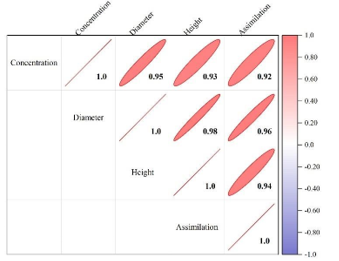Respuesta morfofisiológica de Ochroma pyramidale producida en viveros mediante tecnología biopot a la fertilización con N, P, K utilizando un diseño óptimo personalizado
Contenido principal del artículo
Resumen
Ochroma pyramidale es una especie de rápido crecimiento y alto valor comercial. Los mayores volúmenes de su madera se obtienen de plantaciones comerciales; sin embargo, existen muy pocos estudios sobre su producción en vivero. El objetivo de este estudio fue analizar el efecto de la concentración de N, P, K y la frecuencia de fertilización sobre la respuesta morfofisiológica de O. pyramidale cultivada en tubetes utilizando la metodología de superficie de respuesta. El experimento se estableció utilizando la metodología de superficie de respuesta para lo cual se utilizaron 30 plántulas por corrida experimental. El experimento consistió en aplicar diferentes concentraciones de N, P, K y dos frecuencias de fertilización según el diseño óptimo (personalizado). Las variables de respuesta fueron el aumento de altura, el aumento de diámetro y la asimilación de CO2. A partir de los resultados obtenidos, se confirmó el efecto positivo de la fertilización con N, P y K sobre las variables en estudio. A partir de los datos experimentales se encontró un modelo polinómico cuadrático de segundo orden que permite predecir la respuesta morfofisiológica de la especie. La frecuencia de fertilización durante el intervalo de tiempo estudiado no fue significativa.
Descargas
Detalles del artículo

Esta obra está bajo una licencia internacional Creative Commons Atribución-NoComercial 4.0.
Citas
ANDIVIA, E., FERNÁNDEZ, M., AND VÁZQUEZ-PIQUÉ, J. 2011. Autumn fertilization of Quercus ilex ssp. ballota (Desf.) Samp. nursery seedlings: Effects on morpho-physiology and field performance. Ann. For. Sci. [en línea] vol. 68 no 3: 543-553. doi:10.1007/S13595-011-0048-4.
BORREGA, M., AHVENAINEN, P., SERIMAA, R., y GIBSON, L. 2015. Composition and structure of balsa (Ochroma pyramidale) wood. Wood Sci. Technol. [en línea] vol. 49 no.2: pp. 403-420. doi:10.1007/s00226-015-0700-5.
CAÑADAS-LÓPEZ, Á., RADE-LOOR, D., SIEGMUND-SCHULTZE, M., MOREIRA-MUÑOZ, G., VARGAS-HERNÁNDEZ, J.J., y WEHENKEL, C. 2019. Growth and yield models for balsa wood plantations in the coastal lowlands of Ecuador. Forests [en línea] vol. 10 no. 9. doi:10.3390/f10090733.
FERNÁNDEZ, M., NOVILLO, C., AND PARDOS, J.A. 2006. Effects of water and nutrient availability in Pinus pinaster Ait. open pollinated families at an early age: Growth, gas exchange and water relations. New For. [en línea] vol. 31 no. 3: pp. 321-342. doi:10.1007/s11056-005-8196-8.
FLETCHER, M.I. 1951. Balsa Production and utilization. Econ. Bot. [en línea] vol. 5, no. 2. pp. 107-125. doi:10.1007/BF02984770.
HAWKINS, B.J., BURGESS, D., y MITCHELL, A.K. 2005. Growth and nutrient dynamics of western hemlock with conventional or exponential greenhouse fertilization and planting in different fertility conditions. Can. J. For. Res. [en línea] vol. 35 no. 4: pp.1002-1016. doi:10.1139/x05-026.
LUIS, V.C., PUÉRTOLAS, J., CLIMENT, J., PETERS, J., GONZÁLEZ-RODRÍGUEZ, Á.M., MORALES, D., ANDy JIMÉNEZ, M.S. 2009. Nursery fertilization enhances survival and physiological status in Canary Island pine (Pinus canariensis) seedlings planted in a semiarid environment. Eur. J. For. Res. [en línea] vol. 28 no. 3: pp. 221-229. doi:10.1007/s10342-009-0257-7.
MADRID-AISPURO, R.E., PRIETO-RUÍZ, J.Á., ALDRETE, A., HERNÁNDEZ-DÍAZ, J.C., WEHENKEL, C., CHÁVEZ-SIMENTAL, J.A., AND MEXAL, J.G. 2020. Alternative substrates and fertilization doses in the production of Pinus cembroides Zucc. in nursery. Forests [en línea] vol. 11 no. 1. doi:10.3390/f11010071.
MAHMOUD, A.M.M., AND HUSSEIN, N.R. 2021. Influence of mineral fertilization and different growing media on the growth and chemical composition of Inga edulis Mart. tree seedling. svuijas.journals.ekb.eg [en línea] vol. 3 no. 3: pp. 16-29. doi:10.21608/SVUIJAS.2021.68858.1094.
MARENCO, R.A., DE, J.F., y VIEIRA, G. 2001. Photosynthesis and leaf nutrient contents in Ochroma pyramidale (Bombacaceae). Photosynthetica [en línea] vol. 39 no. 4: pp. 539-543. doi:10.1023/A:1015699927924.
MIYAJIMA, R., VITÓRIA CASTRO SANTOS BARRETO, PAULO ANDRÉ DE OLIVEIRA, GISLAINE CRISTINA BATISTELA, AND DANILO SIMÕES. 2018. Risk Analysis of the Economic Benefits of Ochroma pyramidale: A Case Study of Forest Planting in Brazil. J. Agric. Sci. Technol. B [en línea] vol. 8, no. 7. doi:10.17265/2161-6264/2018.07.004.
OLIET, J.A., PLANELLES, R., ARTERO, F., AND JACOBS, D.F. 2005. Nursery fertilization and tree shelters affect long-term field response of Acacia salicina Lindl. planted in Mediterranean semiarid conditions. For. Ecol. Manage. [en línea] vol. 215 no. 13. pp. 339-351. doi:10.1016/j.foreco.2005.05.024.
SHI, W., GROSSNICKLE, S.C., LI, G., SU, S., y LIU, Y. 2019. Fertilization and irrigation regimes influence on seedling attributes and field performance of Pinus tabuliformis Carr. Forestry [en línea] vol. 92 no. 1: pp. 97-107. doi:10.1093/forestry/cpy035.
TRUBAT, R., CORTINA, J., AND VILAGROSA, A. 2010. Nursery fertilization affects seedling traits but not field performance in Quercus suber L. J. Arid Environ. [en línea] vol. 74 no. 4: pp. 491-497. doi:10.1016/j.jaridenv.2009.10.007. VILLAR-SALVADOR, P., PUÉRTOLAS, J., y PEÑUELAS, J.L. 2009. Assessing Morphological and Physiological Plant Quality for Mediterranean Woodland Restoration Projects. L. Restor. to Combat Desertif. Innov. Approaches, Qual. Control Proj. Eval. [en línea] (Burdett 1990): pp. 103-120. Available from: http://www.research.lancs.ac.uk/portal/en/publications/assessing-morphological-and-physiological-plant-quality-for-mediterranean-woodland-restoration-projects(3769e750-2995-43ac-a859-dc65fc4b0041).html


